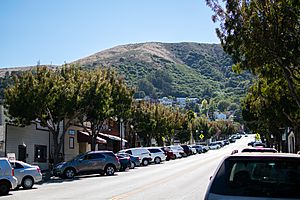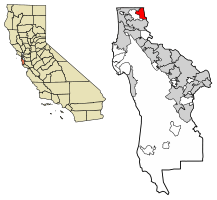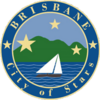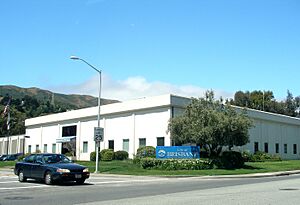Brisbane, California facts for kids
Quick facts for kids
City of Brisbane
|
||
|---|---|---|

Downtown Brisbane, CA
|
||
|
||
| Nickname(s):
City of Stars
|
||

Location of Brisbane in San Mateo County, California.
|
||
| Country | United States | |
| State | California | |
| County | San Mateo | |
| Incorporated | November 27, 1961 | |
| Area | ||
| • Total | 19.97 sq mi (51.71 km2) | |
| • Land | 2.98 sq mi (7.73 km2) | |
| • Water | 16.98 sq mi (43.98 km2) 84.58% | |
| Elevation | 108 ft (33 m) | |
| Population
(2020)
|
||
| • Total | 4,851 | |
| • Density | 1,625.13/sq mi (627.42/km2) | |
| United States Census Bureau | ||
| Time zone | UTC-8 (PST) | |
| • Summer (DST) | UTC-7 (PDT) | |
| ZIP code |
94005
|
|
| Area codes | 415/628 | |
| FIPS code | 06-08310 | |
| GNIS feature ID | 1658137 | |
Brisbane (say "BRIZ-bayn") is a small city in San Mateo County, California. It sits on the lower slopes of San Bruno Mountain. The city is located right next to San Francisco on the San Francisco Bay. In 2020, about 4,851 people lived there.
Brisbane is known as "The City of Stars." This nickname comes from a holiday tradition that started in 1939. Every year, around Christmas and Hanukkah, many people put up large, lit-up stars on their homes and businesses. Some of these stars are as big as 10 feet across! Many residents keep their stars up all year long.
Contents
Exploring Brisbane's Location and Landscape
Brisbane is a city with a unique mix of land and water. It's mostly water, actually!
How Big is Brisbane?
The city covers about 20.1 square miles (52.1 square kilometers). Most of this area, about 17.0 square miles (44.0 square kilometers), is water. The land area is only about 3.1 square miles (8.0 square kilometers).
What is the Brisbane Lagoon?
A big part of Brisbane's water area is the Brisbane Lagoon. This lagoon used to be part of the San Francisco Bay. It was separated when a highway, U.S. Highway 101, was built. Over time, parts of the lagoon were filled in with land.
Where is Guadalupe Valley Creek?
Brisbane is located at the southeast corner of the Guadalupe Valley. A small stream called Guadalupe Valley Creek flows through Brisbane. It runs along the north side of San Bruno Mountain and empties into the Brisbane Lagoon.
A Look at Brisbane's Past
Brisbane has a rich history, from its first inhabitants to how it got its name.
Who Lived Here First?
The first people to live in this area were the Costanoan Indians. They built their homes using branches and reeds. In 1776, Spanish explorers arrived, followed by missionaries. These missionaries created large land grants. Later, when Mexico ruled, these lands became private property.
How Did Brisbane Start?
Brisbane was once part of a huge piece of land called Rancho Cañada de Guadalupe la Visitación y Rodeo Viejo. This land included the Guadalupe Valley and parts of what are now Daly City and San Francisco.
The area was first planned as "Visitacion City" in 1908. This was next to a new rail line built by the Southern Pacific Railroad. The railroad planned to build a large train yard and workshops nearby. They expected to hire over 1,000 workers! However, construction stopped because of a money crisis in 1907. The town didn't grow much for a while. The railroad finally finished the yard and shops by 1918, during World War I.
How Did Brisbane Get Its Name?
In the 1920s, a man named Arthur Annis suggested changing the name from Visitacion City to Brisbane. He thought "Visitacion City" was too confusing because it sounded like a nearby part of San Francisco.
There are two main stories about how the city got its name:
- One story says it was named after Brisbane, Queensland, a port city in Australia. The area in California might have looked similar at the time.
- Another story suggests it was named after a newspaper writer named Arthur Brisbane.
People and Population in Brisbane
The number of people living in Brisbane has grown over the years.
How Many People Live Here?
| Historical population | |||
|---|---|---|---|
| Census | Pop. | %± | |
| 1970 | 3,003 | — | |
| 1980 | 2,969 | −1.1% | |
| 1990 | 2,952 | −0.6% | |
| 2000 | 3,597 | 21.8% | |
| 2010 | 4,282 | 19.0% | |
| 2020 | 4,851 | 13.3% | |
| U.S. Decennial Census | |||
In 2020, the population of Brisbane was 4,851 people. This means about 1,625 people live in every square mile of land.
Who Makes Up Brisbane's Population?
According to the 2010 census, most residents (60.2%) were White. About 25.3% were Asian, and 16.6% were of Hispanic or Latino background. The population is spread out in age, with many adults aged 25 to 64.
Getting Around Brisbane
Brisbane has several ways to get around, whether you're driving or using public transport.
Main Roads in Brisbane
The main road in Brisbane is Bayshore Boulevard. This road goes north into San Francisco and south towards South San Francisco. U.S. Route 101 also passes by the city, running along the eastern side near San Francisco Bay.
Public Transportation Options
SamTrans provides bus service along Bayshore Boulevard. There are also shuttle buses that connect to nearby train stations. These include the Balboa Park BART station, the Sunnydale Muni Metro station (for light rail), and the Bayshore Caltrain Station. These shuttles help residents and workers get to and from the city.
Brisbane's Economy and Jobs
Brisbane is an important place for businesses, with many people coming to work there each day.
What Kind of Businesses Are in Brisbane?
Brisbane's economy mainly relies on office parks and industrial areas. These include Sierra Point and the Valley Drive area. There are also shopping areas in Brisbane Village and along Visitacion and Bayshore Avenues.
The number of people in Brisbane actually doubles during the workday! This is because so many commuters come to work in the city's offices and businesses. Some large companies with offices in Brisbane include Dolby, Cutera Inc., and Intermune. Monster Cable Products and bebe stores have their main offices in Brisbane. The Dakin Building at Sierra Point is a well-known office building.
Future Growth: The Brisbane Baylands Project
There's a big plan called the Brisbane Baylands development. If approved, this project could make the city's job market much bigger. It would add new offices, research facilities, shops, and hotels. These new areas would be easy to reach by public transport, including Caltrain and light rail.
How Much Do Homes Cost?
Homes in Brisbane can be quite expensive. The average home cost is around $639,000. This is higher than the average for all of California, which is about $393,000.
Top Employers in Brisbane
Many companies provide jobs in Brisbane. Here are some of the biggest employers in 2022:
| # | Employer | # of Employees |
|---|---|---|
| 1 | Bi-Rite Food Service Distributors | 243 |
| 2 | Expeditors International of Washington | 242 |
| 3 | LeeMAH Electronics Inc. | 238 |
| 4 | Cutera, Inc. | 226 |
| 5 | Greenleaf Produce | 161 |
| 6 | Ultragenyx | 148 |
| 7 | Amazon Fresh | 142 |
| 8 | Transdev Services Inc | 135 |
| 9 | Hensley Event Resources | 127 |
| 10 | Norman S. Wright Mechanical Equipment | 117 |
Parks and Outdoor Fun in Brisbane
Brisbane is home to beautiful natural areas and city parks.
San Bruno Mountain
San Bruno Mountain is a special place known for its amazing views of the city. It's also home to a rare butterfly called the Mission Blue butterfly.
City Parks to Explore
Brisbane has several parks where you can relax and play:
- Community Park (at 1 Visitacion Ave.) is in the center of town.
- The Fire Hydrant Plug Preserve (at 300 Mariposa St.) is a unique spot.
- Firth Park (at 100 Lake St.) offers more green space.
- The Brisbane Dog Park (at 50 Park Pl.) is a great place for pets.
A Famous Whale Rescue
Brisbane was once the site of a famous animal rescue!
In 1989, a humpback whale named Humphrey the whale swam into the San Francisco Bay by mistake. He ended up stuck on a mudflat north of Sierra Point. His rescue was shown on national TV, and hundreds of people watched from the Dakin Building. Experts from The Marine Mammal Center and the United States Coast Guard worked together to save Humphrey.
Learning and Libraries
The city has a public library that is part of a larger system.
The Brisbane Public Library is a branch of the San Mateo County Libraries. It's also part of the Peninsula Library System, which means you can access resources from many libraries in the area.
See also
 In Spanish: Brisbane (California) para niños
In Spanish: Brisbane (California) para niños




